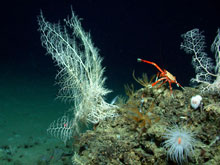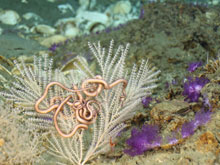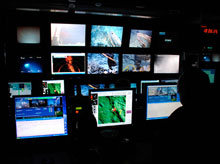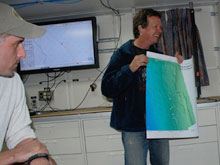Leg 1: The Home Stretch
August 31, 2009
Chuck Fisher
Expedition Chief Scientist
The NOAA Ship Tracker Web site provides current locations on all of NOAA's ships. Click image for larger view and image credit.
If you’ve followed our progress on the NOAA Ship Tracker Web site, you’ve seen our research vessel slowly make its way across the Gulf, from the slopes off the coast of Florida toward the west, off shore from Texas. So far, we’ve been exploring sites that we know a great deal about geologically but less in terms of the kinds and extent of corals that live there. We’ve been on an exploration routine of sorts — steam to a site, launch the remotely operated vehicle (ROV) Jason to find corals, take photos and samples of what we find, recover Jason with samples, and move to the next site. During the transits between sites, everyone works like mad to process the dive’s catch: identifying, measuring and photographing specimens, freezing pieces of tissue for DNA analyses, slicing segments of sediment cores for later sieving and study. It has been a carefully orchestrated dance of exploration, combined with sampling, to maximize our use of the sophisticated (and expensive) deep-sea equipment.

Basket stars, crinoids, anemone, and a crab are all visible on this rock outcropping in the Atwater Valley region in the Gulf of Mexico. Click image for larger view and image credit.
At every site visited, we have found and collected at least a few deep-sea corals, and at some locations we have hit the jackpot. DNA analyses of all of our samples will tell us a lot about the relations among the deep coral populations here in the Gulf of Mexico, and also how these are related to coral populations in the Atlantic Ocean.
At several of the sites, we have discovered a high diversity of black corals, soft corals, and their associated communities. At other sites, we have found widespread occurrence of the hard coral Lophelia pertusa and/or the habitat-forming soft coral, Callogorgia sp. At yet others, we are finding mounds of another hard coral, Madrepora oculata, and the communities of other animals that live within these mounds. (See videos posted with this log for views of Lophelia and Madrepora coral communities.) As the cruise has progressed, we have increased our ability to predict what is living on the seafloor using only remote data collected from a ship.

Callogorgia sp. octocoral with a brittle star (left) and purple soft corals (right) from Green Canyon region in the Gulf of Mexico. Click image for larger view and image credit.
Next Steps: Detailed Studies
We intentionally started this leg of the cruise with dives on sites we did not know much about. For the rest of our leg, we will shift our strategy and dive on sites where we know there are corals in abundance. Our plan for our time on these reefs includes conducting more detailed studies of the fine-scale distribution of the corals, and more intensive physical and photographic sampling of the communities. We will also deploy instruments that will stay on the seafloor until next year, telling us a great deal about the currents, temperatures, sedimentation, and even larval supply to these sites for the next 12 months. Additionally, we will collect live specimens to bring back to our labs for further study, sorting out how changing environmental conditions may or may not affect the corals.
When we combine what we will learn from our explorations of the last two weeks, the intensive ecological studies of the next week, and the physiological studies we will conduct back in our laboratories, we will be a giant step closer to understanding the deep coral reefs of the Gulf of Mexico.

Video monitors inside the Jason Control Van allow scientists and remotely operated vehicle (ROV) Jason crew to see all seafloor operations. Click image for larger view and image credit.




























